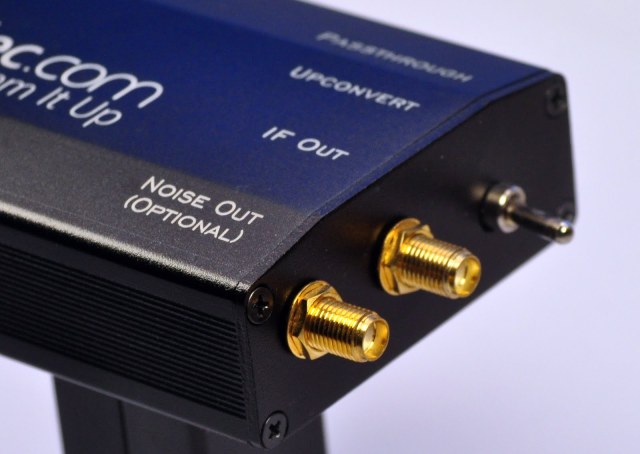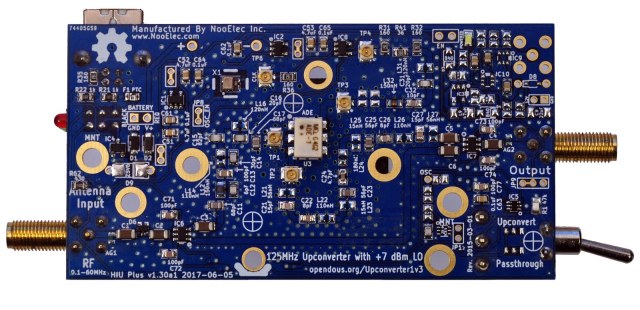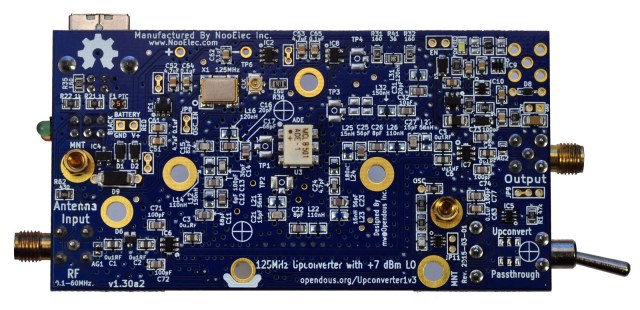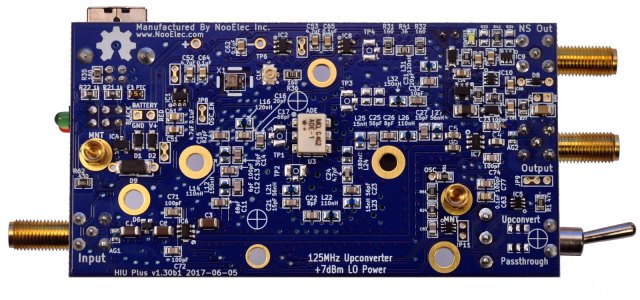An upconverter lets you hear signals below the tuning range of RTL-SDR dongles, so signals less than 30MHz, that’s the entire shortwave / medium wave / longwave spectrum will be audible with a suitable antenna. Works by adding 125 MHz to received signal, so a station on 3MHz will show up at 128 MHz, which falls into the tunable range of every RTL-SDR.
Plus in the name for $65 with free worldwide shipping means it contains a noise source for experimenters: antenna and filter tuning is possible out of the box if you have the knowledge and necessary equipment.
We’re still talking about the predecessor, which can be bought also for much more, ripoffs at $63 and $105 available:
That’s a good sign, if something is in demand, opportunists will try, just use the Official Nooelec Order page to avoid spending more than necessary.
Official Prices
Ham it Up Plus in metal enclosure, subject of this review: $65 plus shipping from manufacturer.
Ham it Up Plus, PCB board only: called Barebones, $50 plus shipping from manufacturer.
Upgrading an existing Ham It Up is easy: enclosure kit for 1.3 and higher sold separately for $16, 125 MHz TCXO upgrade kit is a tenner, noise source kit is another ten dollars. If you got a v1.3 in a metal case you’ll only need to drill one more hole to accommodate one more SMA connector, but at least Nooelec thought of punters who love soldering.
Ham It Up Generations
Let’s look at differences, original version with surface-mounted 100 Mhz oscillator, the first I bought from Nooelec and reviewed five years ago, unpopulated noise source:
Version 1.3a1, you won’t meet these any more, the basis for further improvements, fix 125 MHz oscillator, included here for identification, this is not the latest model:
Version 1.3a2, now what we call the Ham It Up v1.3, distinguishing feature from predecessor are addded screws for easier case mounting:
Version 1.30b1, the latest model also called Plus, easiest to categorize by two SMA antenna connectors above passthrough switch.
Connectors
Power options

Needs 5 Volts via USB Type B cable, which is not supplied, nor can be ordered from Nooelec, big thick square-ish cable for printers, probably used for dependability, USB-B connectors work, SDRPlay also fancies the standard.
Unfathomable, cannot understand, makes me constantly wonder why there’s still no micro-USB port (read: Android smartphone charger plug), or mini-USB (bigger brother, GoPro or Uputronics). All above are 5V, more readily accessible, users can buy a smartphone charger paractically anywhere, whereas you gotta hunt for a printer USB cable.
Just in case, PCB got positive and negative inputs just in case you want to run it off a battery bank, properly labeled. Personally, I just run the upconverter off a $15 power bank, probably not as good as dedicated batteries, but certainly better than a switched-mode power supply or occupying USB port from host computer, and enables easy mobile operation.
Performance
” Input, output and LO filters configured for substantial sensitivity and selectivity improvements” and “Ultra low-noise linear power regulator (LP5907), with voltage noise under 10 µVRMS!”
I can neither confirm nor deny those claims, what’s clear is that in the sub 30 Mhz region the Plus is better than the predecessor; I tended to hear more with the Plus, often substantially more, to the point that a faint signal came in loud and clear – but it must be noted that shortwave reception is very much down to external factors such as atmospheric propagation, so look at the following knowing that switching upcomverters took 15 seconds, same station / dongle / everything:
Regardless of the possibility of tester error, with the same gain setting on the dongle, newer Plus has a noticeably noisier waterfall.
What’s not tested: reception range supposedly extends down to 300 Hz, so it’s theoretically possible to listen to time signals and other low frequency signals, stations I wasn’t interested in as I had no equipment capable of receiving it, hence I have no suitable antennas for proper reception.
Noise source: well, I simply had no time to dwell into the quagmire of “How to use it?”, at first glance, I’d need a directional coupler, and a few weeks off on a beach to soak up the topic and sunkissed margaritas, so this will have to wait. However, just like a sunroof or a towbar it’s good to know the possibility is at hand should it be needed.
Worth it?
Certainly worth the extra few dollars over the regular version, if for nothing else, it’s the latest Ham It Up with extra goodies.
Question gets a little complicated once we throw cost and the availability of higher-class all-in-one SDRs into the equations, and I mean the SDRPlay RSP1: total reception system cost including three antennas is around $140 with an RSP1A, but that’s $140, not $50 for Plus board only.
If you already have an RTL-SDR dongle, true sub-30 MHz capabilities are $50 away, hint: order the Rattlesnake antenna pack for $15 and enjoy three antennas, free worldwide shipping and lots of interesting signals for years to come.
from Radio for Everyone https://ift.tt/2x1ajKW
via IFTTT
from WordPress https://ift.tt/2oTMXTL
via IFTTT














No comments:
Post a Comment